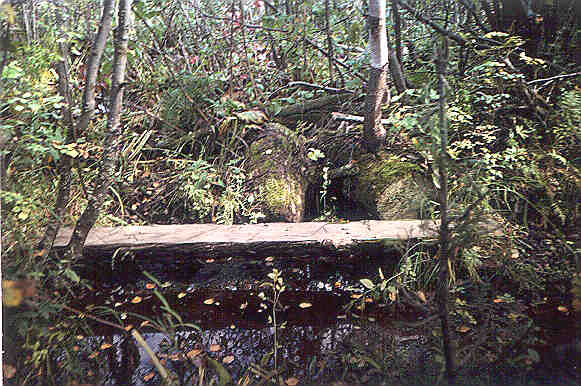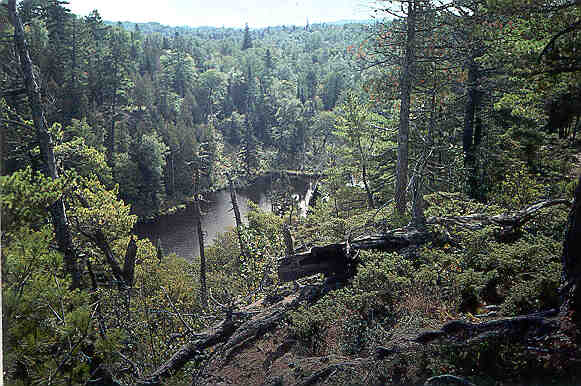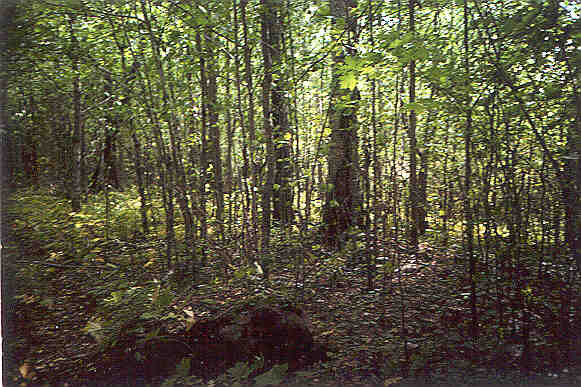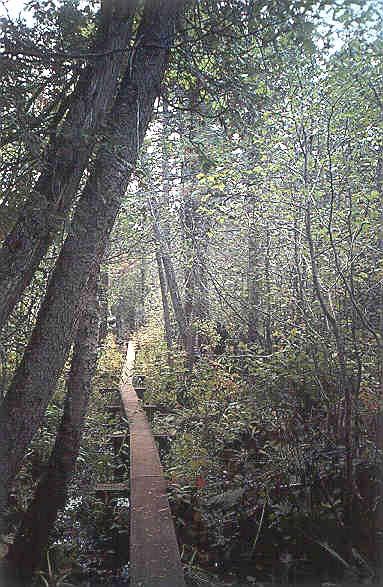Hydrologic Benchmark Network Stations in the Midwestern U.S. 1963-95 (USGS Circular 1173-B)
|
|
|
|
|
Washington Creek at Windigo, Michigan (Station 04001000)
To download a printer friendly PDF version of this information click here.
This report details one of the approximately 50 stations in the Hydrologic Benchmark Network (HBN) described in the four-volume U.S. Geological Survey Circular 1173. The suggested citation for the information on this page is:
|
Mast, M.A., and Turk, J.T., 1999, Environmental characteristics and water quality of Hydrologic Benchmark Network stations in the Midwestern United States, 1963-95: U.S. Geological Survey Circular 1173-B, 130 p. |
All of the tables and figures are numbered as they appear in each circular. Use the navigation bar above to view the abstract, introduction and methods for the entire circular, as well as a map and list of all of the HBN sites. Use the table of contents below to view the information on this particular station.
|
Table of Contents |
| 1. Site Characteristics and Land Use |
| 2. Historical Water Quality Data and Time-Series Trends |
| 3. Synoptic Water Quality Data |
Site Characteristics and Land Use
The Washington Creek HBN Basin is located in the Superior Upland physiographic province on the southwest end of Isle Royale, which is the largest island in Lake Superior (Figure 12. Map showing study area in the Washington Creek Basin and photograph of the landscape of the basin). The 34-km² basin ranges in elevation from 184 to 425 m and drains a landscape of narrow northeast-trending ridges separated by flat stream valleys with numerous wetlands. The USGS gaging station is located 1.3 km northeast of the Windigo Ranger Station at latitude 47×55'23'' and longitude 89×08'42''. Washington Creek, which flows into Windigo Harbor in Lake Superior, has a channel length of about 10.9 km upstream from the gaging station and an average stream gradient of 9.7 m/km. The main channel is perennial, and mean monthly discharge varies from 0.10 m³/s in February to 2.0 m³/s in April during snowmelt. Streamflow normally peaks a second time in October and November owing to increased precipitation and low rates of evapotranspiration. Average annual runoff from the basin was 42 cm from 1965 through 1995 (Blumer and others, 1996). The climate is continental with short, cool summers and cold winters. The mean annual air temperature is 3.4×C, and average annual precipitation is 77 cm (Hansen and others, 1973). Winter snowfall generally begins in October and accumulates in a seasonal snowpack that typically reaches 45 to 60 cm in depth
 |
The Washington Creek Basin is in the Laurentian Mixed Forest ecoregion, which is between the boreal forest and the deciduous forest zones (Bailey and others, 1994). The boreal forest type primarily grows in the northern part of the basin closest to the shoreline (Slavich and Janke, 1993). The predominant species in this area are white spruce, balsam fir, aspen, and paper birch. Farther south in the basin, the soils are thicker, and the climate is somewhat warmer; the forest primarily consists of mature stands of sugar maple and yellow birch. Wetland areas situated between the upland ridges are dominated by black spruce, white cedar, and fir, and some south-facing slopes have stands of jack pine. Most soils in the basin are classified as Spodosols and are mapped in the Graveraet-Michigamme-Rock outcrop soil association (U.S. Department of Agriculture, 1990a). This association is characterized by rock outcrops interspersed with moderately deep (60 to 90 cm), sandy to coarse loamy soils formed in glacial till and loamy mantle material over glacial till (Stottlemyer and Hanson, 1989). The soils tend to be acidic (pH 3.8 to 5.0) and have low exchangeable bases and organic-matter contents in the mineral horizon (Stottlemyer and Hanson, 1989).
Bedrock underlying Isle Royale consists of a thick sequence of basaltic and andesitic lava flows with interbedded conglomerates and sandstones collectively referred to as the Portage Lake Volcanics of Precambrian age (Huber, 1973a, b). The lava flows and sedimentary layers dip to the southeast and are eroded to form a series of long, parallel ridges and valleys. The Washington Creek Basin is primarily underlain by flood basalts, which locally include some sedimentary units. The flood basalts are composed of plagioclase (An60) and pyroxene, which is predominantly augite. Ilmenite and magnetite are major accessory minerals, and chloride, sericite, and calcite are common secondary minerals (Huber, 1973b). Most bedrock in the basin is covered by talus, slopewash, and glacial drift deposits of Pleistocene age. Till deposits are deepest and most extensive in the southwestern part of the basin. The tills have a high carbonate content that probably is derived from calcareous deposits brought south from Hudson Bay by Pleistocene glaciers (Huber, 1973b).
The Washington Creek Basin is located in Keweenaw County in Michigan on the western end of Isle Royale in Lake Superior and is entirely in the boundaries of Isle Royale National Park. The basin is accessible by way of Windigo, on the western end of the island, by using seaplane service from Houghton, Mich. (118 km to the south), or by ferry service from Grand Portage, Minn. (35 km to the west). The park is open to the general public from April 15 to November 1, and regular transportation services operate from mid-June through October. During the winter, the site is accessible by ski plane or helicopter. The gaging station can be reached by a 1.7-km hiking trail from Windigo. The basin is undeveloped, except for two maintained hiking trails. A campground, ranger station, and weather station are located at Windigo, which is downstream from the gaging station.
 |
Although the basin has remained undisturbed since the establishment of the National Park, the ecosystem has been modified by land uses in the past (Shelton, 1975). Mineral exploration for native copper deposits occurred in the Windigo area from 1889 to 1893, including an extensive drilling project to locate ore deposits. Although few deposits were ever mined, fire was commonly used by prospectors to remove vegetation from the bedrock. The only logging in the HBN basin occurred in the 1890's when white cedar and pine were cut along Washington Creek. Part of the basin was burned in 1936 when a logging-related fire destroyed almost one-third of the forest cover on the island. Natural factors also have affected the forests of Isle Royale, including spruce budworm epidemics and trends in the moose population (Hansen and others, 1973). The Civilian Conservation Corps constructed trails, fire towers, and buildings on the island in the 1930's, and the Isle Royale National Park was formally established in 1940. The management policies of Isle Royale National Park are described in the most recent version of the general management plan for the park (U.S. Department of the Interior, 1998). In addition to Washington Creek, water quality on Isle Royale also is monitored at the Wallace Lake study site (Stottlemyer and Hanson, 1989) located on the east end of Isle Royale approximately 40 km east of the HBN station. The Wallace Lake study site was established in 1982 as part of a network of field research sites in National Parks designed to study the structure and function of environmentally sensitive ecosystems and their response to disturbance, such as atmospheric contaminant inputs and global climate change (URL http://www.mesc.usgs.gov/norocky, accessed 1998).
Historical Water-Quality Data and Time-Series Trends
The data set for the Washington Creek HBN Station analyzed for this report includes 146 water-quality samples that were collected from September 1967 through August 1995. Sampling frequency was monthly in 1968 and 1969, bimonthly from 1970 through 1982, and quarterly from 1983 through 1995. Water-quality samples in the early part of the period of record were analyzed at a USGS laboratory in Columbus, Ohio, that operated until 1973 (Durum, 1978). After establishment of the central laboratory system, samples were analyzed at a laboratory in Atlanta, Ga., from 1973 through 1985 and at the NWQL in Arvada, Colo., from 1986 through 1995. Daily discharge records for Washington Creek (station 04001000) are available beginning in October 1964. Records of daily water temperature at the gaging station are available from October 1964 through September 1991.
 |
Calculated ion balances for 139 samples with complete major-ion analyses are shown in Figures 13a and 13b. Temporal variation of discharge, field pH, major dissolved constituents, and ion balance at Washington Creek, Michigan. Ion balances ranged from -8.9 to 13 percent, and about 80 percent of samples had values within the ±5 percent range, indicating that the analytical results are of high quality. The average ion balance was 1.5 percent, and 68 percent of the samples had positive ion balances, indicating a slight excess of measured cations over anions in solution. Time-series plots of the major dissolved constituents were inspected for evidence of method-related effects (fig. 13). The most notable pattern was observed in sulfate, which had a period of elevated concentrations during the late 1980's. This pattern coincides with the use of a turbidimetric titration for sulfate analyses at the NWQL in Arvada, Colo., between March 1986 and December 1989 (Fishman and others, 1994). In 1989, the laboratory determined that sulfate concentrations can be overestimated by this method and changed the method to ion chromatography in 1990 (Office of Water Quality Technical Memorandum No. 90.04, Turbidimetric Sulfate Method, issued December 21, 1989, at URL http://water.usgs.gov/admin/memo/, accessed 1997). The bias was most pronounced in dilute waters, although it was not consistent among samples and seemed to be affected by factors such as color and turbidity (Schertz and others, 1994). The positive bias in sulfate concentrations also is reflected in the ion balance, which was consistently lower than average during this period of record.
Median concentrations and ranges of major constituents in stream water at the Washington Creek Station and VWM concentrations in wet-only deposition measured at the Wallace Lake NADP Station are listed in table 22. Precipitation chemistry at the NADP station, which is about 40 km east of the HBN station on the east end of Isle Royale, is dilute and slightly acidic with a VWM pH of 4.8 for 11 years of record. The predominant cations in precipitation were hydrogen and ammonium, which contributed 35 and 38 percent of the total cation charge. The predominant anions were sulfate, which accounted for 61 percent of the total anions, and nitrate, which accounted for 36 percent. The predominance of strong acid anions indicates that precipitation on Isle Royale may be affected by anthropogenic emissions of sulfur and nitrogen compounds, which cause acid rain (Stottlemyer and Hanson, 1989).
Table 22. Minimum, first quartile, median, third quartile, and maximum values of physical properties and major dissolved constituents measured in water-quality samples from Washington Creek, Michigan, September 1967 through August 1995, and volume-weighted mean concentrations in wet precipitation collected at the Wallace Lake Station, Michigan
[Concentrations in units of microequivalents per liter, discharge in cubic meters per second, specific conductance in microsiemens per centimeter at 25 degrees Celsius, pH in standard units, and silica in micromoles per liter; n, number of stream samples; VWM, volume-weighted mean; inst., instantaneous; spec. cond., specific conductance; <, less than; --, not reported]
|
Parameter |
Stream Water |
Precipitation VWMa |
|||||
|
Minimum |
First quartile |
Median |
Third quartile |
Maximum |
n |
||
| Discharge, inst. |
0.014 |
0.065 |
0.15 |
0.48 |
4.4 |
145 |
-- |
| Spec. cond., field |
57 |
98 |
130 |
170 |
250 |
141 |
13 |
| pH, field |
6.6 |
7.3 |
7.5 |
7.7 |
8.1 |
145 |
4.8b |
| Calcium |
360 |
650 |
900 |
1,050 |
1,600 |
145 |
7.9 |
| Magnesium |
180 |
330 |
420 |
530 |
800 |
145 |
2.2 |
| Sodium |
39 |
96 |
130 |
170 |
360 |
145 |
1.4 |
| Potassium |
<2.6 |
10 |
13 |
15 |
31 |
145 |
.7 |
| Ammonium |
<.7 |
1.4 |
2.1 |
2.9 |
26 |
61 |
17 |
| Alkalinity, laboratory |
400 |
820 |
1,220 |
1,510 |
2,120 |
145 |
-- |
| Sulfate |
8.3 |
92 |
120 |
160 |
460 |
142 |
29 |
| Chloride |
<2.8 |
51 |
85 |
140 |
420 |
146 |
1.6 |
| Nitrite plus nitrate |
<.7 |
3.6 |
7.1 |
7.1 |
15 |
102 |
17c |
| Silica |
98 |
160 |
200 |
230 |
270 |
146 |
-- |

